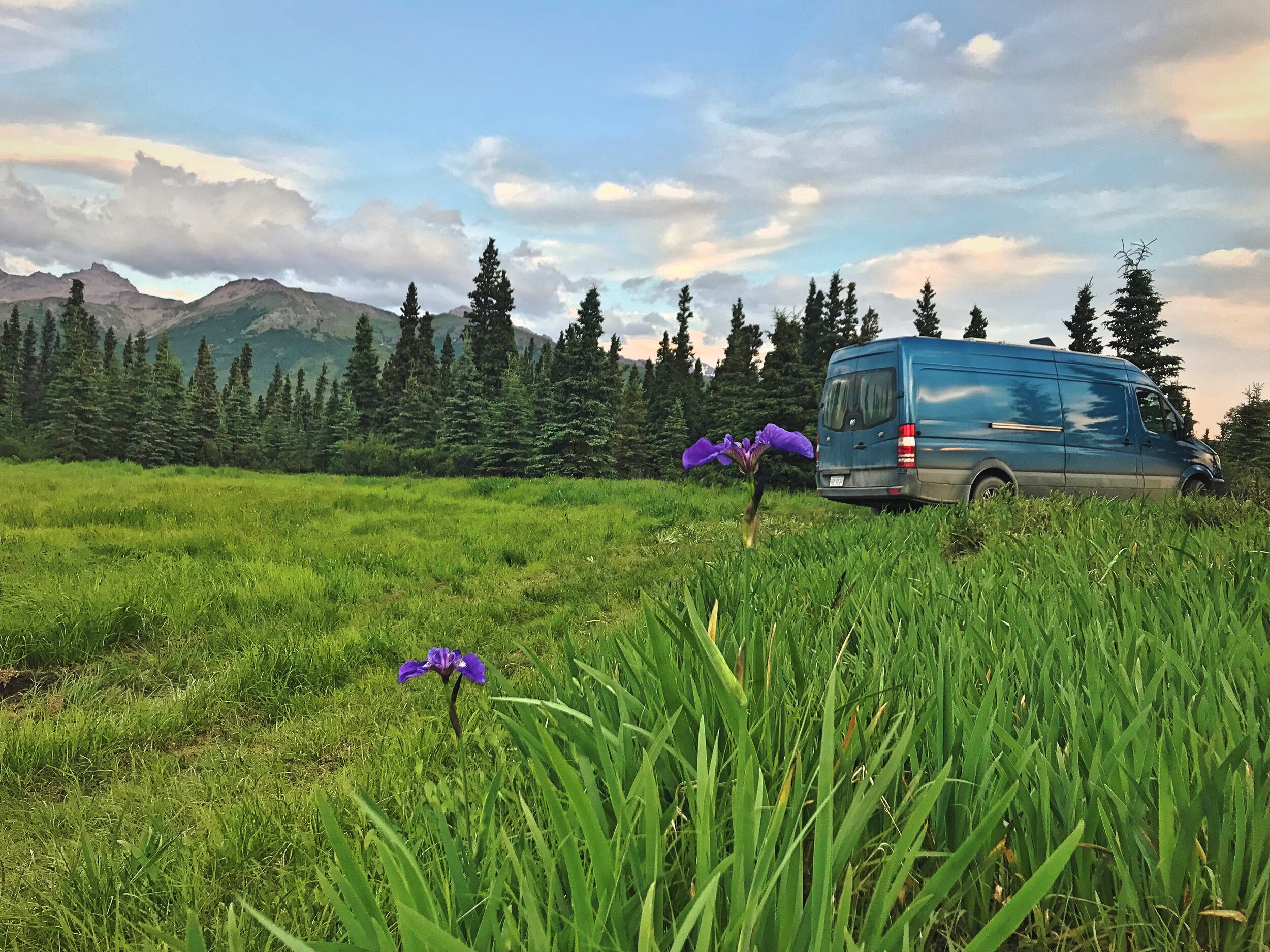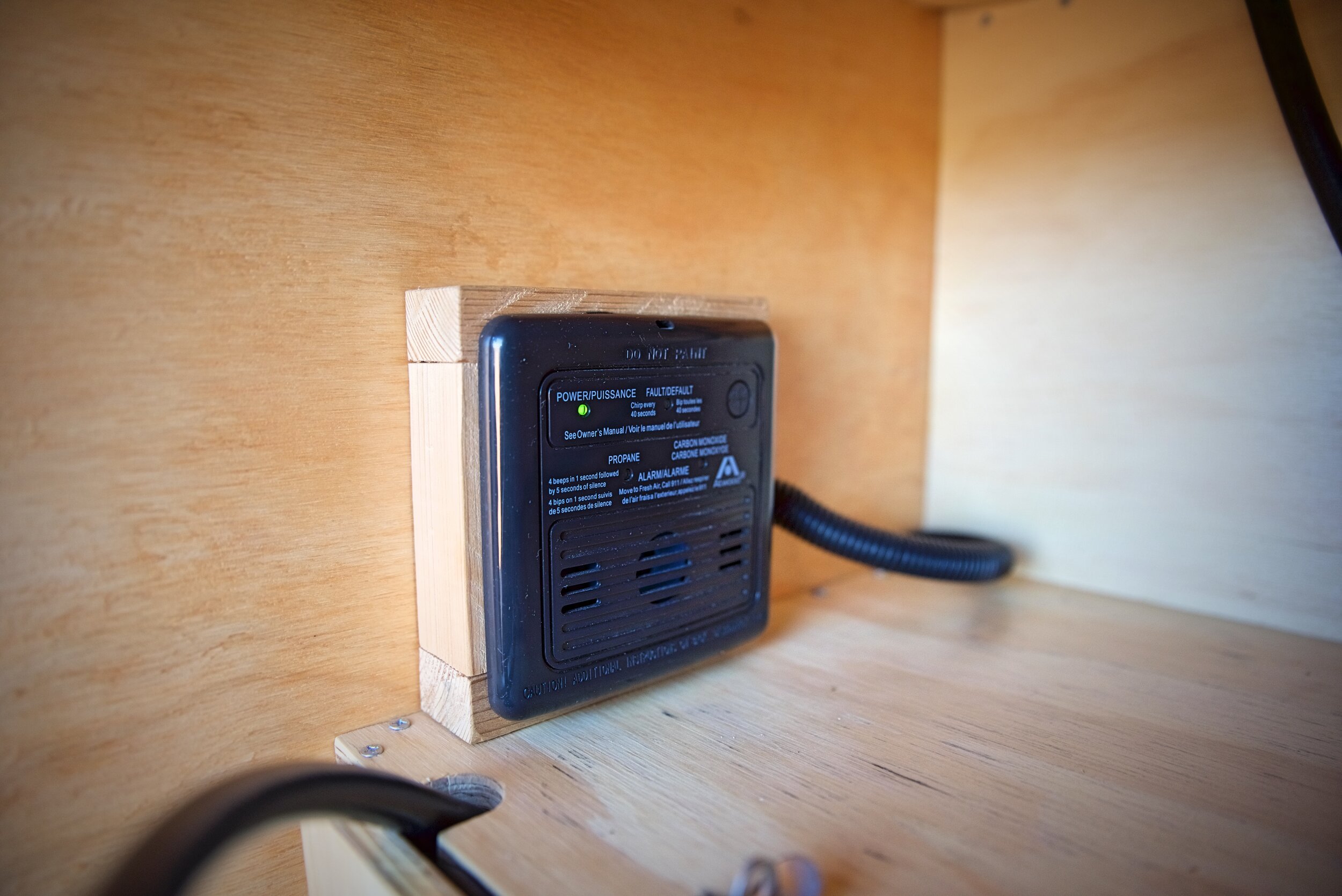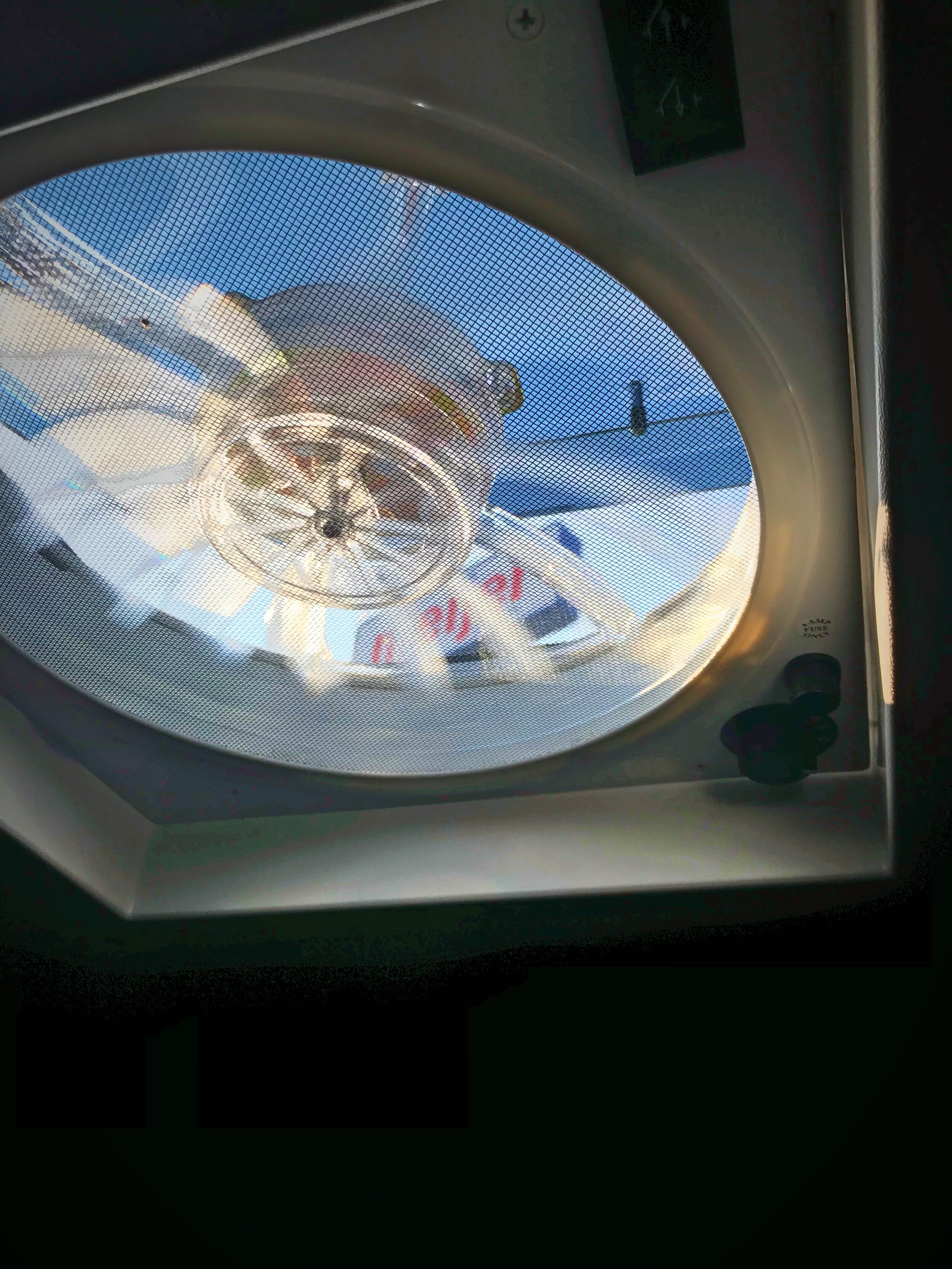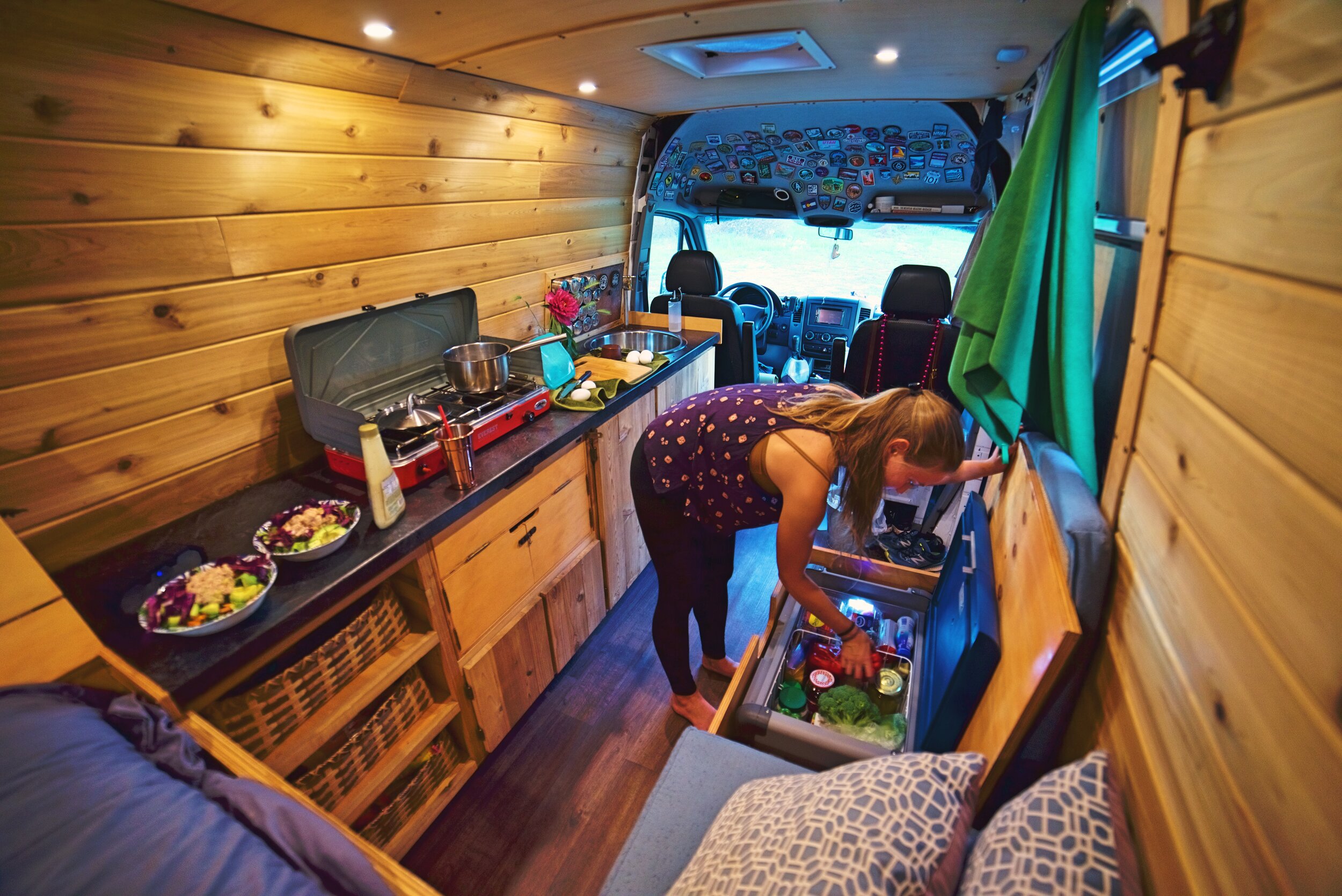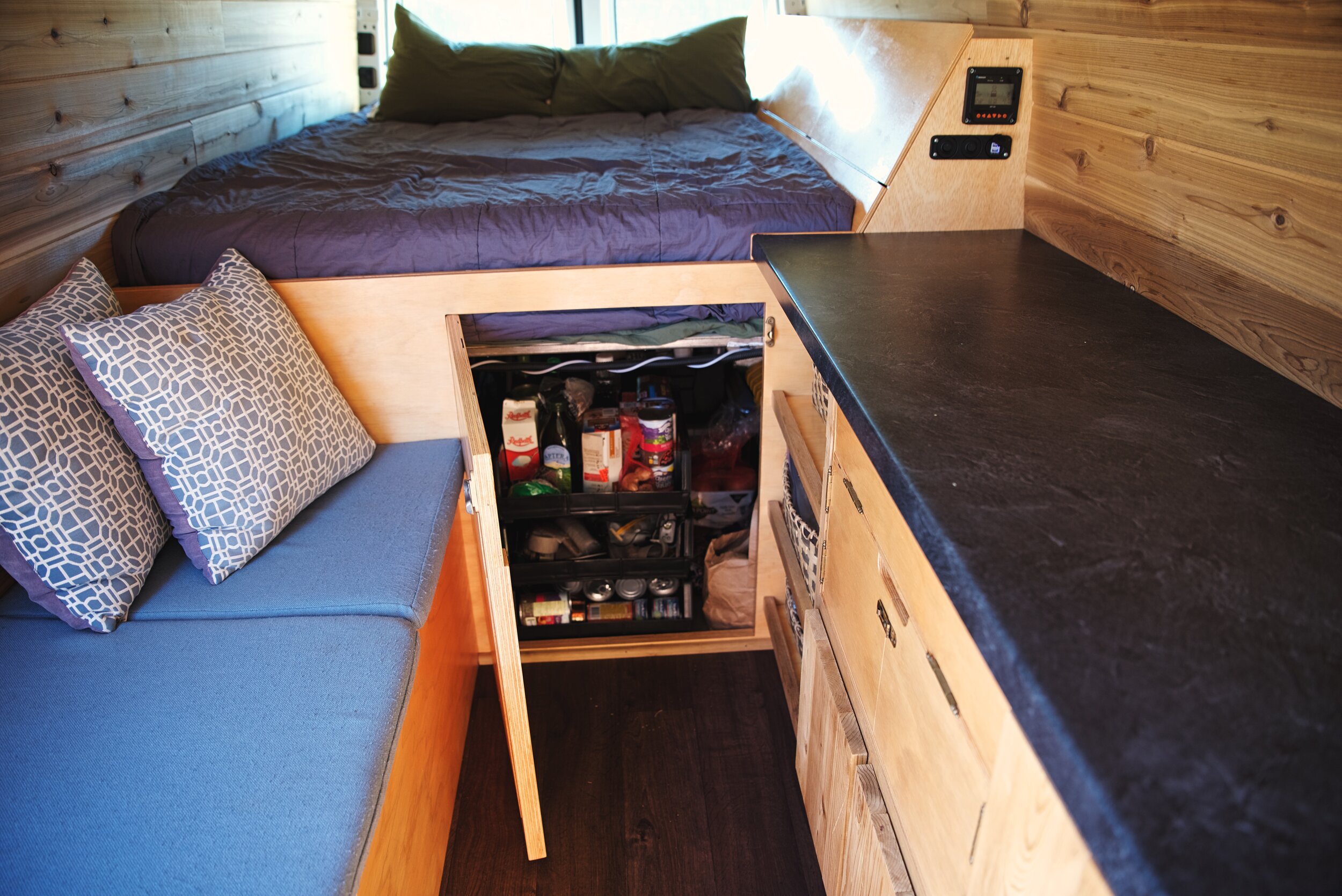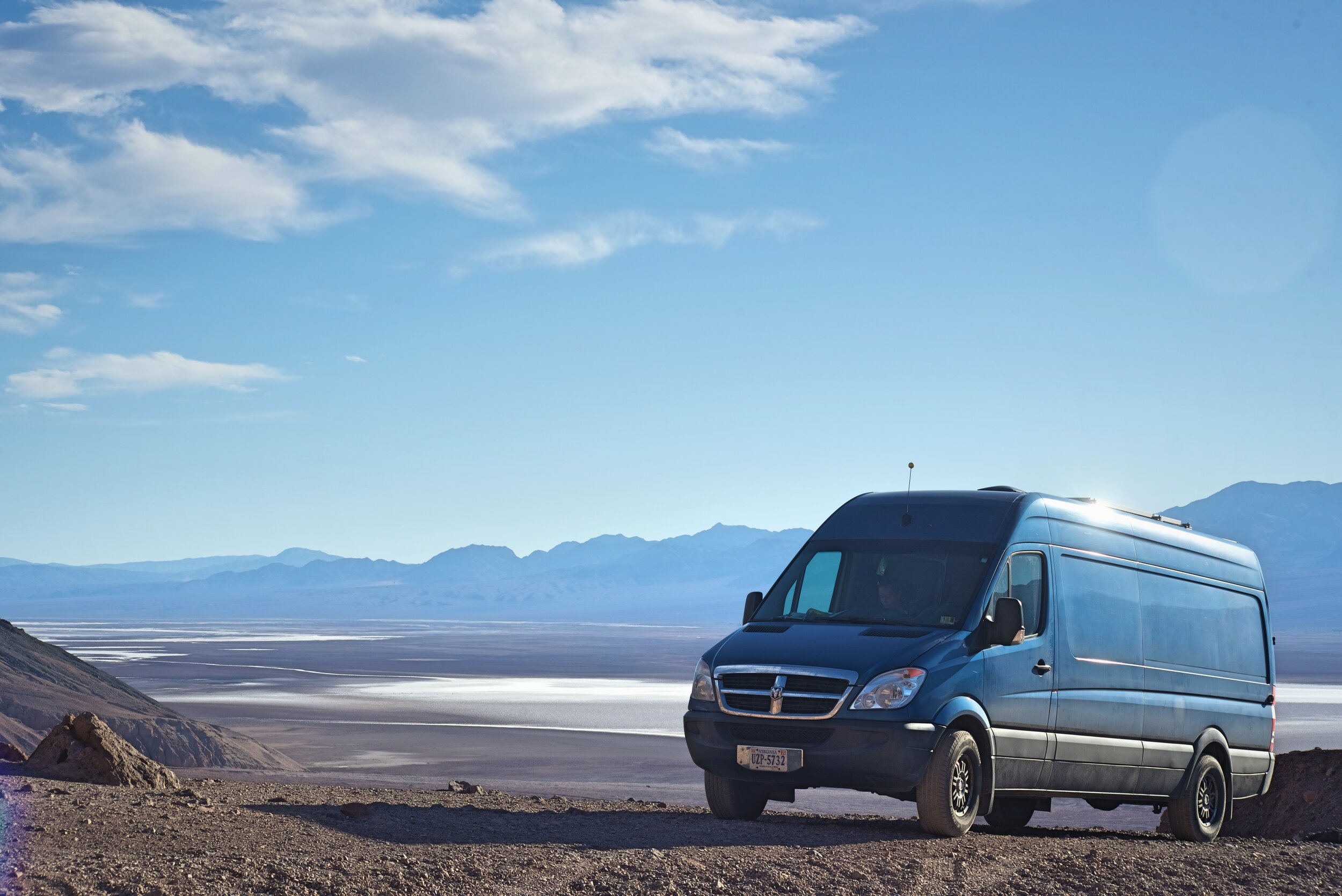How To Select a Battery for Your Camper Van Solar Power System
Adding a solar power system to your camper van will allow you to spend time in the most remote, off-grid destinations. Boondocking in the desert of Nevada? Check! Driving through the Redwood Forest? Check! Stranded in Kentucky during a break down? Check!
Solar power will allow you to spend time boondocking rather than staying at expensive campgrounds.
Solar power will help you get off the grid in truly remote locations, like this campsite in Alaska.
Without a doubt, a solar power system will give you a lot more flexibility while traveling. But making the calculations of how much solar power you need, what equipment to buy, and how to size the battery can be totally overwhelming. In this article we share how to choose a solar battery for your camper van’s house batteries.
Selecting the best battery for your van’s solar power system should be an individualized process. Rather than having us tell you “this is the best” battery, you should pick your ideal battery based on your budget, how you plan to live in your van, and your comfort working with electrical systems.
Picking the Right Size Battery
The first step to selecting the right size battery for your camper van is to calculate your estimated energy draw. It can be very difficult to determine your draw prior to living in your van, but that’s why it’s very important to plan out your van as much as you can prior to building it out rather than just figuring things out as you go.
When calculating your draw, don’t forget about small devices like your propane/CO detector.
Calculating your energy load requires estimating how much you will use each device in your van.
Start by thinking about what you will power in your camper van. Think about things like how much will you use your computer or if you will want to charge camera batteries? Do you want to use household appliances like a blender or a hair straightener? How big is your fridge? Purchasing a high-efficiency 12-volt fridge will significantly lower your energy draw. Don’t forget to add in easily overlooked items like outlets, lights, fans, and propane/CO detector.
You can find out how to calculate your draw in more detail in our full, detailed article about our camper van’s solar power system.
The fridge will be one of the biggest draws in your van, so it makes sense to purchase a high-efficiency 12-volt fridge.
Types of Solar Power Batteries
There are several different types of batteries that are commonly utilized in camper van builds for solar power systems. Batteries can be broken into two categories: lead acid (which includes flooded lead acid batteries-FLA and sealed lead acid batteries-SLA) and lithium ion batteries.
Each type of battery has it’s own pros and cons for vanlife solar power systems and might be utilized in different situations.
Testing out our van’s solar power battery before putting it into our van.
Each type of battery has different pros and cons for using in a camper van solar system.
Flooded Lead Acid Batteries
Flooded lead acid batteries, or FLA batteries, are your standard type of battery that you’d find in a car or a golf cart. They also have the longest history of usage in solar power systems. They are very cheap, and they can have a long life span…if they are maintained properly.
Unfortunately, even though they are the cheapest, flooded lead acid batteries are not the safest for a van conversion. FLA batteries are filled with a liquid electrolyte that is moves freely within the battery encasement around the lead plates. If the battery breaks or corrodes, you will have battery acid everywhere. Another downside is that this electrolyte needs to be topped off every few months.
Probably the biggest con to utilizing flooded lead acid batteries is that when they are charging, they off-gas toxic hydrogen gas, so you need to build a sealed container that is externally vented. That means that FLA batteries might not actually be the cheapest choice for your van build out. We do not recommend that you utilize FLA batteries in your van conversion.
The power converted from your solar panels gets stored in your battery so it is essential to pick the right one.
FLA batteries aren’t a great choice for most van builds because batteries are kept in an inconvenient place like under the bed with little ventilation.
Sealed Lead Acid Batteries
Sealed lead acid batteries, or SLA batteries, are similar to flooded lead acid batteries in the way that they work, except that the electrolyte compartment is sealed, making it safer. SLA batteries won’t leak, spill, or off-gas, and there’s no need refill the batteries. The downside is that there is only pre-determined number of cycles allocated in the electrolyte, which means that these batteries may not last as long for your camper van and they cannot be refurbished.
There are two primary types of SLA batteries: AGM batteries and gel batteries.
SLA batteries balance safety and budget for your camper van solar power system.
It is important to have other components like a charge controller to keep your battery healthy.
AGM Batteries
AGM or absorbed glass mat batteries hold the electrolyte fluid suspended in fiberglass mats between the lead plates inside the battery. These batteries cost more than FLA batteries, but there is no need for maintenance or ventilation. These batteries are durable and there is no risk of spilling the electrolyte.
AGM is what we recommend for your van build if you are on a tight budget.
Gel Batteries
Gel batteries are not so different from AGM batteries, except that the electrolyte is held in a thick paste rather than in mats. Again there is no need for maintenance, and you don’t need to worry about leaking and off-gassing.
Gel batteries are the most expensive type of lead acid battery, however, gel batteries have a higher charge and discharge rates than AGM batteries. They are a really good choice if you need a long, slow discharge, such as if you will be leaving your van parked for any period of time.
Gel batteries are the most sensitive type of battery and require a solar charge controller set to the correct parameters.
Gel batteries are a great choice if you will be spending time in hot climates.
Gel batteries are the most sensitive of the batteries you could put in your van, meaning that you will need a quality solar charge controller set to the correct parameters to ensure that you are properly charging and discharging your gel battery. If you don’t, you may severely reduce the lifespan of your battery.
Gel batteries also have a better lifespan if they will be in hot temperatures, like the sealed interior of a van parked in Death Valley for example. For this reason, we opted to use a Renogy 200Ah Deep Cycle Gel Battery in our van build. Overall we have been extremely satisfied with the performance of our battery.
Lithium Ion Batteries
Lithium ion batteries, or LiFePO4 batteries, work in a different way from lead acid batteries. They are similar to the battery that is found in your phone. Compared to lead acid batteries, lithium ion batteries are lightweight and safe. Again, there is no need for maintenance or off gassing.
One of the biggest advantages of a lithium ion battery is that they can be discharged and stored at almost zero percent, with no long term damage to the battery. That means that when you buying a 100aH battery, you’re getting the full 100aH rather than 50aH as you get in a lead acid battery. Lead acid batteries by comparison should only be drawn down to 50 percent of their capacity (and ideally not that much even). For example a 200Ah lead acid battery, actually only has a 100Ah of capacity.
Lithium ion battery’s downside that they can’t be charged below freezing which could be issue if you’re spending time in wintery climates.
However with a little temperature control (and the right budget), a LiFePo4 battery would be a great choice.
The downside of lithium ion batteries is that they are expensive. However, if you have the budget this is the way to go. They have the longest lifespan, which in the long run will make them the most economical for your build if you can spend the money up front. Lithium ion batteries have come down a lot in price in the last few years, and there is a good chance that if we were building out our camper van right now, we might opt to go with lithium ion Batteries.
However, another downside of lithium ion batteries is that they cannot be charged below freezing so if you plan on spending a lot of time in cold places you may need to add some temperature control in your van for the sake of your solar power system.
Other Considerations
When selecting a battery for your camper van you will also want to consider how compatible the battery will be with other devices and how complex it will be to install. Wiring multiple golf cart batteries in series and building a compartment for exterior ventilation is going to be a significantly more complex installation than going with a complete solar set up from a company like Renogy.
We opted to go with a Renogy battery partially because we knew we could purchase solar panels, solar meter, charge controller, inverter, and even some of the larger cables all from Renogy. It was easy to ensure that all the components were compatible and sized correctly. There are even solar power kits that you can purchase from Renogy that can make building out your solar system in your camper van super easy.
When considering a solar battery you should also consider how easily you can install it.
Selecting the right solar battery for your van will keep you powered even in the most remote places.
Another reason to opt for components from a brand like Renogy or Battleborn is that these companies designed for off-grid, mobile solar systems in boats and RVs. They are built to be durable for vibration and withstand temperature fluctuations.
Looking for more information about camper van solar? We’ve outlined ever step of our van’s solar power system to help make your build out easier.
Posts Also tagged:
AGM Batteries, Battery, Boondocking, Flooded Lead Acid Batteries, Fridge, Frugal Travel, Gel Batteries, LiFePo4 Batteries, Propane System, Sealed Lead Acid Batteries, Solar Panels, Solar Power, Travel, Van Build, Van Build Budget, Van Build Planning, Van Conversion, Van Electrical, Van Fan, Van Kitchen, Van Lights, Van Outlets, Vanlife, Vanlife Essentials, Winter, Winter Travel
Which battery did you pick for your solar power in your van? Let us know in the comments below.



